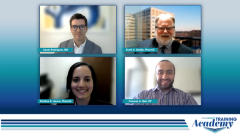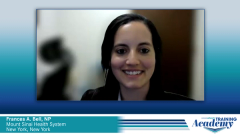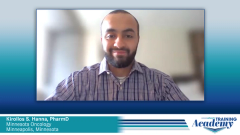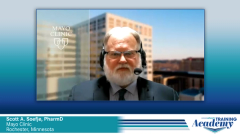
Non-BCMA Targeting Bispecifics in MM and Future Directions in Care
Before closing out their discussion with key takeaways, expert panelists highlight novel non-BCMA targeting bispecifics in the setting of multiple myeloma.
Episodes in this series

Transcript:
Cesar Rodriguez, MD: And then we have other agents, not just BCMA [B-cell maturation antigen]-directed therapy. Franny, you have a lot of experience with GPRC5D [targeted by] talquetamab, [and] FcRH5 [targeted by] cevostamab, which are 2 other bispecifics that are potentially going to be available commercially in the next few years. What other side effects are you seeing with these agents that we also need to factor in when we’re thinking of treating, and financial toxicity?
Frances A. Bell, NP: Some of the other toxicities with those agents that we see are GI [gastrointestinal] toxicity, some skin and dermatologic toxicities, and the same infection risk and prophylaxis needs to be taken into account.
Cesar Rodriguez, MD: We’re seeing GI and skin side effects that we were not seeing before, especially with GPRC5D, which is talquetamab.
For the other GPRC clinical trial, the other agent. These agents are causing nail changes. It’s causing dysacousia and affecting taste. These are other side effects that also potentially require dental evaluations, a dietitian or nutritionist to help with oral care that might impact the patient if they’re having the dysacousia and problems with eating. Also, podiatry if we’re seeing that the nail changes could potentially increase their risk of ingrown nails or infections, especially since a lot of the times we use shoes that we shouldn’t be using or don’t fit properly. Then for cevostamab, or the FcRH5 targeting agent, is another bispecific that is coming down the pipeline. We don’t see as many infections as we’re seeing with BCMA-directed therapies and we don’t see the nail and taste toxicity as GPRC5D, but we’re seeing cytopenias and we’re still seeing infections in this agent. These are more bispecifics and more immunotherapies that we’re going to have to be looking into as we go forward and as this field of immunotherapy expands in the management of multiple myeloma. Hopefully this will help us better care for our patients, give them a better lifestyle, and give them a longer lifespan. It also raises a whole bunch of new questions. With this, I’d like to close and would like to ask each one of you to share some key takeaways on the treatment of myeloma patients with bispecifics and what you would advise the community colleagues. I’d like to start with Kirollos. What do you want to tell other community physicians with this therapy?
Kirollos S. Hanna, PharmD, BCPS, BCOP: First and foremost, it was a great discussion with you all. It was really great just to see the different perspectives and how we all can care for our patients. Also, the exciting updates just in myeloma in general. For the community setting, establishing some modality where you do have a relationship or some type of way to connect with your local hospitals that can give this in a safe manner. I absolutely think, as we discussed, that in the future, CAR T-cell therapy, bispecific therapies, and so on will likely become much more digestible in the outpatient setting from the beginning. Maybe CAR T, that can take some time, but at least with the bispecifics, particularly the different targets that we have and generations that we have once we establish those patients in the community setting. A lot of community settings don’t have hospital affiliations. Building some type of framework or infrastructure to ensure that in the rare cases where some severe or fatal adverse events do manifest, there will be a very quick response. Obviously, there’s a lot of room for staff education across the board as we continue to see these advancements in therapy. But thank you all again.
Cesar Rodriguez, MD: Franny, with all you’re experiencing [with] bispecifics [in] patients in clinic and caring for them on a continuous basis, what take away points would you like to say?
Frances A. Bell, NP: I think for me, seeing bispecifics both in the clinical trials and now commercially, my biggest takeaway is seeing our patients who are on 4th, 5th, and 6th lines of therapy, for however long, have not seen a complete remission or they’ve always had measurable disease. Now with bispecifics, and with teclistamab in particular, we’re seeing a lot of patients get down into complete remission and not have a measurable M [monoclonal] spike anymore. It’s very amazing and exciting to see the new bispecifics that will be coming out as well.
Cesar Rodriguez, MD: We’re seeing a big change in care for myeloma patients and hope that we can control the disease better and get the patients to live longer. Hopefully, that’ll motivate community physicians to be open to receiving these patients, maybe not for the first part, but as part of the maintenance. Scott, from your standpoint, any takeaways and from the financial standpoint in terms of the cost of agents or the financial burden that this could have for the academic centers or institutions doing the step-ups and also for the community practices?
Scott A. Soefje, PharmD, MBA, BCOP, FCCP, FHOPA: I think the take-home message from the conversation today is we’re just at the beginning of this whole process and it is going to evolve and change over the next several years. I think it’s going to be very important for providers, payers, patients to all sit down sometime and figure out how are we going to pay for this? How are we going to pull this off? How are we going to make it the most palatable to everybody so that we’re not bankrupting patients and we’re not financially burdening providers and health systems yet we’re not draining payers dry either? There’s got to be some way to figure this all out. And it’s going to be the sequencing. It’s going to be how we do the stepping, how we do the transitions of care, all of that’s got to be figured out. I think the last player that’s got to come to the table is Pharma and they have to sit down with us and say, “OK, you can’t just keep raising the prices of these drugs if you’re not showing us the benefits we need.” So let’s start figuring out how we make this whole process work or the system is just going to break and we’re going to have to sit back and go, “OK, I don’t want to be the one telling a patient, you can’t get this drug because we can’t afford to give it to you.” I don’t want to ever be in that situation and I don’t think anybody does. I don’t want to tell a patient, “You can’t get this drug because you can’t afford to pay for it.” That puts too much burden on the people who already have a significant burden that’s going on in their life at this point in time. So my advice is pay attention, get involved, and really watch this space as it evolves.
Cesar Rodriguez, MD: Thank you so much. Some takeaways that I would like to point out are, and they’ve been already mentioned, we’re still learning. We’re in a learning phase right now. Every time there’s a new thing or a new agent, we learn. When we started treating patients with IMiDs [immunomodulatory drugs], we learned about the side effects of immune modulators and the risk of clots. When we started to play with proteasome inhibitors, we started to deal with neuropathy, which was something that we were not seeing before. Also shingles reactivation, we learned how to deal with it and how to partner with neurologists or pain specialists to help manage neuropathy. When we started with belantamab mafodotin [Blenrep], which unfortunately, right now, is not available, but might become available again in the near future, we had to partner with ophthalmologists to look for eye toxicities and be able to treat them in conjunction. These immunotherapies that we’re now using, yes, we’re learning on how to deal with CRS [cytokine release syndrome]. We’re learning on how to deal with neurotoxicity. These are side effects that we wish we didn’t have and we’re still learning to try to find a way of mitigating them. These are things that we just have to learn how to deal with for now and learn to collaborate with other specialists that maybe we hadn’t collaborated with or relied on before to try to treat the patient better. In terms of the financial aspect, some of the things that we need to focus on how we can lower the cost of this for the patient, the financial burden for the patient, and also keep in mind aspects that are not normally covered by insurance like transportation, time off work, and if they need lodging. Encourage industry, organizations, and societies to try to find and develop funds that can be used to assist in these areas that insurance might not be assisting in. We have a lot to learn. Exciting times. These agents are amazing in terms of the results that we’re seeing. It comes with some side effects, it comes with a lot of growing pains, and learning process, but it is something that is here to stay. We’re just going to have to improve it and get better at it. I don’t see us going back because of the excellent responses that we’re seeing with these agents. I want to thank the panelists, Frances Bell, Dr Soefje, and Dr Hanna for this rich and informative discussion. To our viewing audience, thank you for joining us. We hope you found this Cancer Network® Training Academy session on “Bispecifics in Multiple Myeloma: Payer Perspectives” to be useful and valuable to the treatment of your patients with myeloma. We hope that you are motivated to treat patients in the community setting and feel comfortable talking and asking questions with other myeloma specialists to help facilitate this; thank you.
Transcript edited for clarity.
Newsletter
Stay up to date on recent advances in the multidisciplinary approach to cancer.





































































































